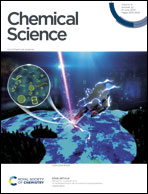Photoredox radical/polar crossover enables C–H gem-difunctionalization of 1,3-benzodioxoles for the synthesis of monofluorocyclohexenes†
Abstract
A photocatalytic C–H gem-difunctionalization of 1,3-benzodioxoles with two different alkenes for the synthesis of highly functionalized monofluorocyclohexenes is described. Using 4CzIPN as the photocatalyst, the direct single electron oxidation of 1,3-benzodioxoles allows their defluorinative coupling with α-trifluoromethyl alkenes to produce gem-difluoroalkenes in a redox-neutral radical polar crossover manifold. The C–H bond of the resultant γ,γ-difluoroallylated 1,3-benzodioxoles was further functionalized via radical addition to electron-deficient alkenes using a more oxidizing iridium photocatalyst. The capture of in situ generated carbanions by an electrophilic gem-difluoromethylene carbon and consecutive β-fluoride elimination afford monofluorocyclohexenes. The synergistic combination of multiple termination pathways of carbanions enables rapid incorporation of molecular complexity via stitching simple and readily accessible starting materials together.

- This article is part of the themed collections: Most popular 2023 organic chemistry articles and In celebration of the Lunar New Year, 2024


 Please wait while we load your content...
Please wait while we load your content...